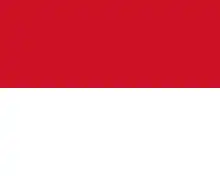Eurovision Young Dancers 1985
The Eurovision Young Dancers 1985 was the first edition of the Eurovision Young Dancers, held at Teatro Municipale in Reggio Emilia, Italy on 16 June 1985.[2] Organised by the European Broadcasting Union (EBU) and host broadcaster Radiotelevisione Italiana (RAI), dancers from eleven countries participated in the televised final.
| Eurovision Young Dancers 1985 | |
|---|---|
| Dates | |
| Final | 16 June 1985 |
| Host | |
| Venue | Teatro Municipale, Reggio Emilia, Italy |
| Presenter(s) | Carla Fracci Gheorghe Iancu[1] |
| Directed by | Eros Macchi Nevio Sivini |
| Executive supervisor | Frank Naef |
| Executive producer | Ilio Catani |
| Host broadcaster | Radiotelevisione Italiana (RAI) |
| Website | youngdancers |
| Participants | |
| Number of entries | 11 |
| Debuting countries | |
Participation map
| |
| Vote | |
| Voting system | A professional jury chose the top 3 participants. |
| Winning dancers | Arantxa Argüelles |
Arantxa Argüelles of Spain won the contest, with Norway and Sweden placing second and third respectively.[3]
Location
.jpg.webp)
Teatro Municipale (also since the 1980s called the Teatro Municipale Valli due to being named after the actor Romolo Valli), a theatre in Reggio Emilia, Northern Italy was the host venue for the 1985 edition of the Eurovision Young Dancers.[2]
Following the destruction by fire of the 1741 Teatro Cittadella in April 1851, the new theatre was designed by the architect Cesare Costa and constructed in the neoclassic style between 1852 and 1857.[4] Its inauguration took place on 21 April 1857 with the performance of the Vittor Pisani by local composer Achille Peri.
Format
The format consists of dancers who are non-professional and between the ages of 16–21, competing in a performance of dance routines of their choice, which they have prepared in advance of the competition. All of the acts then take part in a choreographed group dance during 'Young Dancers Week'.[5]
Jury members of a professional aspect and representing the elements of ballet, contemporary, and modern dancing styles, score each of the competing individual and group dance routines. The overall winner upon completion of the final dances is chosen by the professional jury members.[5]
The interval act was a ballet performance from presenters repertoire.[1]
Results
Final
Awards were given to the top three countries. The table below highlights these using gold, silver, and bronze. The placing results of the remaining participants is unknown and never made public by the European Broadcasting Union.[3]
| Draw | Country | Participant | Place |
|---|---|---|---|
| 01 | Anneke Lönnroth | - | |
| 02 | Arantxa Argüelles | 1 | |
| 03 | Ariane van de Vyver and Ben Huys | - | |
| 04 | Arne Fagerholt | 2 | |
| 05 | Christine Landault and Stephane Elizabe | - | |
| 06 | Jeanette den Blijker and Ruben Brugman | - | |
| 07 | Maria Almeida[lower-alpha 1] and Errol Pickford | - | |
| 08 | Mia Stagh and Göran Svalberg | 3 | |
| 09 | Sabrina Vitangeli | - | |
| 10 | Stefanie Eckhof | - | |
| 11 | Xavier Ferla | - | |
Jury members
The jury members consisted of the following:[7]
 Denmark – Peter Schaufuss (chairman)[6]
Denmark – Peter Schaufuss (chairman)[6] United Kingdom – Alicia Markova
United Kingdom – Alicia Markova Italy – Paolo Bortoluzzi
Italy – Paolo Bortoluzzi Monaco/
Monaco/.svg.png.webp) Russia — Marika Besobrasova
Russia — Marika Besobrasova Brazil – Helba Nogueira
Brazil – Helba Nogueira
Broadcasting
The 1985 Young Dancers competition was broadcast in at least 11 countries.
Notes and references
Notes
- Shortly before the contest, it was announced that Almeida would replace Viviana Durante.[6]
References
- "Radiocorriere TV". 1985.
- "Eurovision Young Dancers 1985: About the show". European Broadcasting Union. Retrieved 5 October 2014.
- "Eurovision Young Dancers 1985: Participants". youngmusicians.tv. European Broadcasting Union. Retrieved 5 October 2014.
- Lynn, Karyl Charna, Italian Opera Houses & Festivals, Lanham, MD: Scarecrow Press, 2005 ISBN 0-8108-5359-0 p. 235
- "Eurovision Young Dancers - Format". youngdancers.tv. European Broadcasting Union. Archived from the original on 11 February 2015. Retrieved 8 March 2015.
- "Eurovision Young Dancer of the Year - BBC Two England - 16 June 1985". BBC Genome Project. Retrieved 18 June 2017.
- http://cdmyd.mcu.es/cnd/pdf/programa-de-mano-33.pdf
